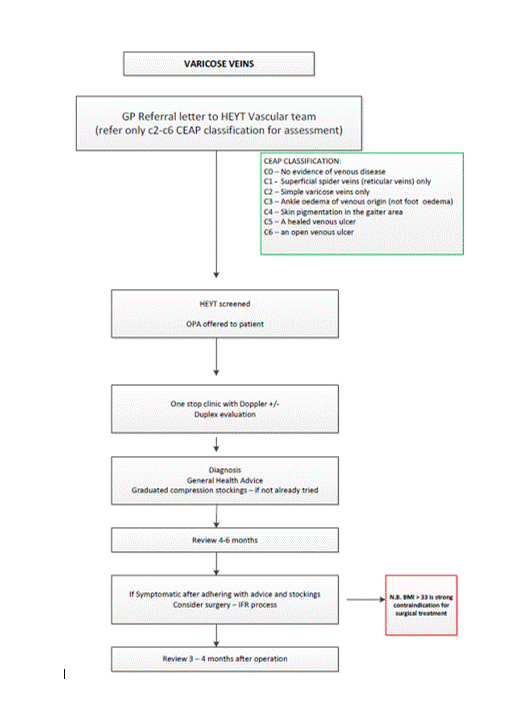Varicose Veins
Definition/Description
Varicose veins are veins under the skin of the legs, which have become widened, bulging, and twisted. They are very common and do not cause medical problems in most people. Varicose Veins are often hiereditary and more likely to occur in women, especially during pregnancy. Most pregnancy induced varicose veins improve within 3 months after delivery. Other predisposing factors include ageing, standing for long periods of time, obesity and leg injury.
Red Flag Symptoms
Most Varicose veins are non-symptomatic and do not cause a medical risk, however In some cases Varicose Veins relate to Deep Vein Thrombosis. If a DVT is suspected, refer to the Community DVT service at Westbourne Health Centre.
Do Not Refer
- No visible or palpable signs of venous disease
- Telangectasia or reticular veins
- Varicose veins
- Oedema
Guidelines on Management
All recommendations relate to adults aged 18 years and over.
Give people who present with varicose veins information that includes:
- An explanation of what varicose veins are. Patient leaflet is available.
- Possible causes of varicose veins.
- The likelihood of progression and possible complications, including deep vein thrombosis, skin changes, leg ulcers, bleeding and thrombophlebitis. Address any misconceptions the person may have about the risks of developing complications.
- Treatment options, including symptom relief, an overview of interventional treatments and the role of compression.
Advice on:
- Weight loss (for guidance on weight management see Obesity [NICE clinical guideline 43]) – link to weight management pages.
- Light to moderate physical activity.
- Avoiding factors that are known to make their symptoms worse if possible.
- When and where to seek further medical help.
GPs are free to refer varicose veins for assessment at Vascular Clinic. Please inform the patient that varicose vein surgery will only follow if clinically necessary and Vascular department apply for IFR funding and this is approved. Please see Humber CCG Evidence-based interventions policy
Stockings are effective in controlling symptoms, especially in oedema, and preventing skin complications. They are only effective if worn regularly, but can reliably avoid the need for surgery in the majority of patients.
Referral Criteria/Information
Referrals should be made to the HEYHT Vascular team by GP letter indicating the severity of the varicose veins following CEAP (Clinical, Etiological, Anatomical and Pathophysiological) classification as detailed in NICE guideline CG168 (July 2013) Varicose Veins in the legs. Referrals are accepted for varicose veins categorised as C4 to C6 in the CEAP guides.
Information to Include
- Patient details
- Severity of varicose veins
- BMI
- Treatments followed prior to referral
Additional Resources & Reference
Associated Policies
Specialties
Places covered by
- east-riding
- hull
Hospital Trusts
- hull-university-teaching-hospitals
